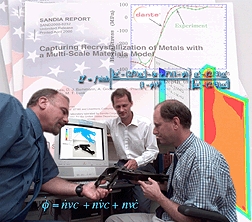|
Sandia materials model wins R&D 100 award
|

BREAKTHROUGH — Three members of the team that won an R&D 100 award for technological innovation at Sandia this year, (from left to right) Doug Bammann, Mark Horstemeyer and Mike Chiesa, display a control arm from a Cadillac steering system, a part designed with their winning mechanical-property code. This potentially revolutionary code allowed the part to be designed with a nearly 30 percent weight savings, and accurately predicted where the part would break during mechanical testing.
Download 300dpi JPEG image, ‘RD100.jpg’, 305K (Media are welcome to download/publish this image with related news stories.)
|
LIVERMORE, CA — A research group led by the Department of Energy’s Sandia National Laboratories has won an R&D 100 award for innovative technology from R&D Magazine. The team created materials modeling software to optimize design of automotive parts and reduce waste in heat treatment of gears.
The team was led by Doug Bammann, who specializes in theoretical and applied mechanics. The Sandia team is among 20 winners from Department of Energy facilities in this year’s competition.
The 12 members of the winning team have been told their model is potentially revolutionary in the way it efficiently streamlines design of finished parts. They will receive plaques Sept. 27, at a banquet hosted by the magazine at Chicago’s Museum of Science and Industry.
“This year’s R&D 100 awards recognize the Department of Energy’s continued contribution to our nation’s economic prosperity and well-being,” said Secretary of Energy Bill Richardson. “Energy Department laboratories are a wellspring of innovation and I congratulate the researchers on their success.”
The material modeling software takes into account a wide range of metals: tantalum, steel, aluminum, copper, and more, Bammann said. It can be run on any computer platform.
“A person on the shop floor could run the program and see how to adjust for distortion,” he said. “It allows you to track, physically, what’s happening with the material and predict the material response.”
Already, it’s been used to decrease by nearly 30 percent the material needed to create a Cadillac control arm (part of the car’s steering system). Optimizing automotive parts allows cars to be lighter, and thus more fuel-efficient, which helps lower emissions. This optimization also decreases material costs and permits better quality parts.
Sandia researcher Mark Horstemeyer said he was able to predict where, during testing, the control arm would ultimately break in mechanical tests. When his prediction was eventually borne out, he said, he received immediate applause from representatives of 40 companies involved in the cooperative research.
The work is known as the “USCAR-USAMP-AMD Project: Design and Optimization for Cast Light Metals.” This five-year Cooperative Research and Development Agreement (CRADA), which ended last year, involved the U.S. Council for Automotive Research’s U.S. Automotive Materials Partnership’s Automotive Metals Division.
“Various casting programs have been trying to accomplish ‘prediction models’ for years, but it finally took a very accurate material model that captures true physics of deformation and damage to show where failure would occur,” commented Don Penrod, the American Foundrymen’s Society executive administrator for the project. In a letter supporting the award nomination, General Motors Corporation staff development engineer Richard Osborne heralded this “very unique, yet practical, capability that could revolutionize the process for designing automotive components.” He explained, “Other material models do not have the accuracy of this model because they do not include microstructure and discontinuity information.”
Those qualities, Horstemeyer said, influence how a part will fail mechanically. These pertinent cause-and-effect relationships were included in the model, which requires a small set of data and can be run relatively rapidly for very complicated situations.
Related work was carried out under a six-year CRADA with the Ann Arbor, Mich.-based National Center for Manufacturing Sciences, a cross-industry consortium with more than 200 member companies. In this work, the microstructure-property model was applied to simulate heat treatment and quenching applications for a variety of steels, and incorporated in a software package, scheduled to be released by NCMS soon, named DANTETM.
Besides improving automotive parts, team members believe this modeling approach also can be applied to crashworthiness analysis for all types of vehicles, including trains and aircraft. The model is being used to understand how upper mantle convection applies to earthquakes and volcanoes, and will be extended to the behavior of small parts in microelectromechanical systems.
Team members include: Bammann; Horstemeyer; Mel Callabresi; Mike Chiesa; Jim Lathrop; Esteban Marin; Vince Prantil; Richard Regueiro; Paul Taylor (current or former Sandians); George C. Johnson (University of California at Berkeley); Mark Lusk (Colorado School of Mines); and David McDowell (Georgia Institute of Technology).
Sandia is a multiprogram laboratory operated by Sandia Corporation, a Lockheed Martin Company, for the United States Department of Energy under contract DE-AC04-94AL85000. With main facilities in Albuquerque, N.M., and Livermore, Calif., Sandia has major research and development responsibilities in national security, energy and environmental technologies, and economic competitiveness.
Media contact:
Nancy Garcia, negarci@sandia.gov, (925) 294-2932
Technical contacts:
Doug Bammann, bammann@sandia.gov, (925) 294-2585
Mark Horstemeyer, mfhorst@sandia.gov, (925) 294-2816
Mike Chiesa, chiesa@sandia.gov, (925) 294-2103
|
